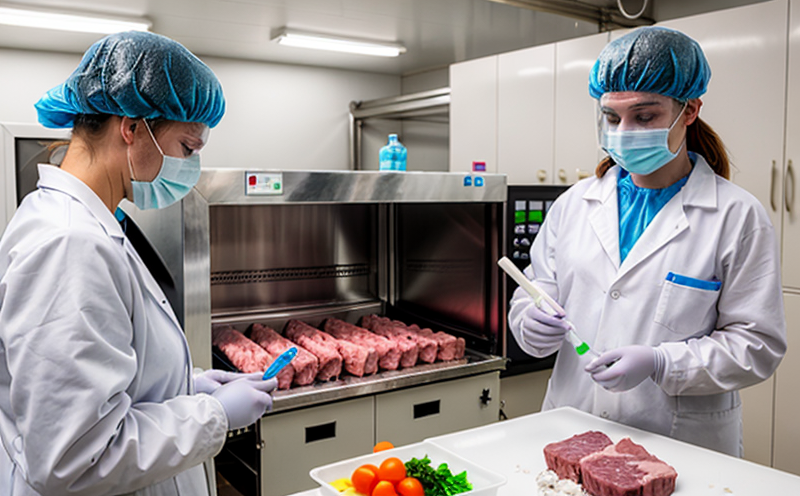EN ISO 16140 Validation of Microbiological Methods in Food
The EN ISO 16140 standard outlines a validated method for the evaluation and validation of microbiological methods used in food safety testing. This process is critical for ensuring that laboratory tests are accurate, reliable, and consistent across different environments and laboratories. By validating these methods against this international standard, food producers can ensure compliance with global regulatory requirements.
The primary goal of EN ISO 16140 is to establish a standardized procedure for the validation of microbiological methods used in food testing. This includes both culture-based and culture-independent methods. The validation process ensures that these methods yield reproducible results, which are essential for accurate detection and quantification of microorganisms.
EN ISO 16140 is applicable to a wide range of foods and food products, including dairy and meat products. In the context of dairy and meat microbiology testing, this standard provides detailed protocols for validating methods used in detecting pathogens such as Listeria monocytogenes, Salmonella spp., and Escherichia coli O157:H7.
The validation process typically involves several stages, including method selection, preparation of test samples, inoculation with known quantities of microorganisms, incubation periods, and the use of appropriate media for growth. The results are then compared against a reference method to ensure consistency and accuracy. This rigorous testing ensures that the methods used in food safety laboratories meet stringent quality control standards.
By adhering to EN ISO 16140, laboratories can demonstrate their commitment to maintaining high-quality standards in microbiological testing. This is particularly important for industries such as dairy and meat processing, where strict hygiene practices are essential to prevent contamination and ensure product safety. The standard also helps reduce the risk of false positives or negatives, which could lead to unnecessary recalls or consumer harm.
In addition to ensuring compliance with international standards, EN ISO 16140 validation also supports continuous improvement in laboratory practices. Regular revalidation helps identify any potential issues that may arise over time due to changes in equipment, reagents, or environmental factors. This ongoing process of quality assurance is vital for maintaining trust and confidence among stakeholders.
The scope of EN ISO 16140 includes not only the validation of microbiological methods but also the assessment of their performance characteristics. These characteristics may include precision, accuracy, specificity, sensitivity, and robustness. By evaluating these parameters, laboratories can better understand the limitations and strengths of each method, allowing for more informed decision-making when selecting appropriate testing protocols.
For dairy and meat microbiology testing specifically, EN ISO 16140 provides detailed guidelines on how to validate methods used in detecting specific pathogens that are common in these industries. This includes procedures for preparing samples, inoculating cultures, incubating them appropriately, and interpreting results based on internationally recognized criteria.
By following the steps outlined in this standard, laboratories can ensure that their testing practices align with global best practices. This not only enhances operational efficiency but also contributes to overall food safety by providing accurate and reliable information about microbial contamination levels within products.
Industry Applications
| Application Area | Description |
|---|---|
| Dairy Processing Facilities | Validation of methods used in detecting Listeria monocytogenes and other pathogens. |
| Meat Packaging Plants | Evaluation of techniques for identifying Salmonella spp. and E. coli O157:H7. |
| Food Safety Laboratories | Assessment of microbiological methods employed in routine quality control checks. |
| Retail Food Chains | Sustained monitoring of products for potential contamination during storage and distribution. |
Why Choose This Test
- Ensures compliance with international standards (ISO 16140).
- Improves accuracy and reliability of microbiological results.
- Reduces the risk of false positives or negatives in food safety testing.
- Promotes consistency across different laboratories and environments.
- Supports continuous improvement through regular revalidation processes.
- Enhances overall operational efficiency within food processing facilities.
- Contributes to improved public health by ensuring safer products reach consumers.
Use Cases and Application Examples
In the dairy industry, EN ISO 16140 validation is crucial for ensuring that milk samples are accurately tested for potential contamination with harmful bacteria. For instance, a quality assurance team at a large-scale dairy farm might use this standard to validate its method of detecting Listeria monocytogenes in raw milk before it undergoes pasteurization.
In the meat sector, validation of microbiological methods plays an integral role in ensuring that processed meats are free from dangerous pathogens like Salmonella and E. coli O157:H7. A meat packaging plant might apply EN ISO 16140 to verify its testing procedures for these specific bacteria during production.
Food safety laboratories often rely on validated methods as part of their routine quality control measures. By adhering to this standard, they can ensure that all tests conducted meet the highest levels of accuracy and precision required by regulatory bodies worldwide.
Retail food chains also benefit from EN ISO 16140 validation by implementing sustained monitoring programs aimed at preventing product contamination throughout storage and distribution processes. This helps maintain consumer trust and satisfaction while reducing recalls associated with contaminated goods.





